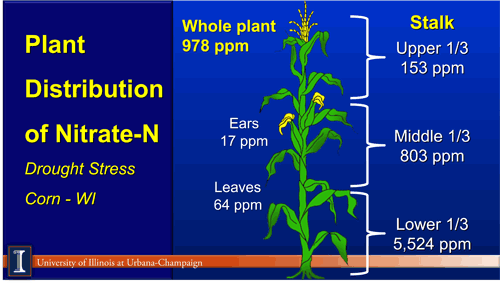On Monday, August 27, Hoard's Dairyman hosted a special webinar. With drought conditions affecting so much of the United States, the feed supply will be limited and for much of the country, the quality of feed will be altered due to the hot and dry conditions. "Sorting through your forage supply options" was presented by Mike Hutjens, University of Illinois, and it addressed some alternative feed options.
The hour-long webinar was recorded and is archived on the Hoard's Dairyman website at www.hoards.com/webinars. Here are the key points of the presentation. We encourage you to watch the presentation for the full content.
"Eyes wide open," is how Mike Hutjens explained how we need to approach the various options available for feed this year. The possibilities include drought-stressed corn silage, drought-stressed soybeans, fall small grain annuals and winter small grain annuals.
While not ideal, drought-stressed forages can be fed, but must be tested to ensure they are safe to feed to lactating and young breeding stock. "It's a different crop!" stressed Hutjens. It needs to be carefully evaluated.
Nitrate levels can be high in drought-stressed forages. Chopping higher can minimize risk, but lowers yields by about one ton per acre for each chopped foot. Test your forage. Nitrate levels over 17 ppm should not be fed and levels of Nitrate-N over 4,000 ppm should not be fed. The health of animals is important, but the safety of people is paramount. "No one, and I mean no one, should enter any storage area without an oxygen tank! The nitrogen gases are deadly," Hutjens stated emphatically.

Higher sugar content is also seen in drought-stressed corn and yeast loves sugar. Lab tests from recently harvested forages show the sugar content as high as 7 percent, as compared to 1 percent during a typical year. Inoculants can help with fermentation when sugar levels are elevated.
Mycotoxins can impact animal health. Some common issues include immune system suppression, rumen disorders, loose fecal matter, reduced dry matter intake (up to 2 pounds per cow) and hormonal changes. The levels of aflatoxins that are considered safe vary depending on the animal being fed. Lactating cows, breeding stock and beef steers all have different maximum levels.
Drought-stressed soybeans can be fed, but are not real palatable. Hutjens cautioned to carefully check the insecticide and herbicide levels. There can be carryover, which can appear in milk as residues and cost you producers significantly in the loss of milk income and penalties. The small grains can be an option if the growing conditions in your area are agreeable.
If you are in the position to buy forages, Hutjens asks these questions:
The hour-long webinar was recorded and is archived on the Hoard's Dairyman website at www.hoards.com/webinars. Here are the key points of the presentation. We encourage you to watch the presentation for the full content.
"Eyes wide open," is how Mike Hutjens explained how we need to approach the various options available for feed this year. The possibilities include drought-stressed corn silage, drought-stressed soybeans, fall small grain annuals and winter small grain annuals.
While not ideal, drought-stressed forages can be fed, but must be tested to ensure they are safe to feed to lactating and young breeding stock. "It's a different crop!" stressed Hutjens. It needs to be carefully evaluated.
Nitrate levels can be high in drought-stressed forages. Chopping higher can minimize risk, but lowers yields by about one ton per acre for each chopped foot. Test your forage. Nitrate levels over 17 ppm should not be fed and levels of Nitrate-N over 4,000 ppm should not be fed. The health of animals is important, but the safety of people is paramount. "No one, and I mean no one, should enter any storage area without an oxygen tank! The nitrogen gases are deadly," Hutjens stated emphatically.

Higher sugar content is also seen in drought-stressed corn and yeast loves sugar. Lab tests from recently harvested forages show the sugar content as high as 7 percent, as compared to 1 percent during a typical year. Inoculants can help with fermentation when sugar levels are elevated.
Mycotoxins can impact animal health. Some common issues include immune system suppression, rumen disorders, loose fecal matter, reduced dry matter intake (up to 2 pounds per cow) and hormonal changes. The levels of aflatoxins that are considered safe vary depending on the animal being fed. Lactating cows, breeding stock and beef steers all have different maximum levels.
Drought-stressed soybeans can be fed, but are not real palatable. Hutjens cautioned to carefully check the insecticide and herbicide levels. There can be carryover, which can appear in milk as residues and cost you producers significantly in the loss of milk income and penalties. The small grains can be an option if the growing conditions in your area are agreeable.
If you are in the position to buy forages, Hutjens asks these questions:
- What are the actual nutrients of the crop?
- What are the nitrate levels?
- How well will it ferment?
- What level of risk are you willing to take?
- What replacement feed costs are there?
- How will this impact any crop insurance or government programs?
- What nutrients will be needed to be replaced if a crop is taken as a silage?
- Is it most economical to sell the crop or leave it in the field?









